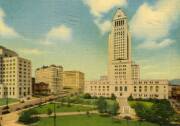Revisiting the L.A. cold case of the Black Dahlia.
Support your source for local news!
Today, put a dollar value on the trustworthy reporting you rely on all year long. The local news you read here every day is crafted for you, but right now, we need your help to keep it going. In these uncertain times, your support is even more important. We can't hold those in power accountable and uplift voices from the community without your partnership. Thank you.
More Stories
-
The story of Ted Ngoy and the community of Cambodian refugees behind every donut.
-
Los Angeles established the country's first Playground Department Commission 120 years ago.
-
There are only a few traditional drive-ins left in the region. At one point, there were around 70 between L.A. and Orange Counties alone. What happened?
-
The zanja system of pipes and trenches was first built in 1781, and remnants can still be seen in the city today.
-
The Black-owned shop has been at its current location since 1977. It was part of a string of Black businesses that sprang up when much of L.A. was still segregated.
-
PBS SoCal is trying out a new experiment by streaming Howser’s Visiting on YouTube, 24 hours a day, seven days a week.
-
We explore the origins of how the ear-cringing accent really evolved in the San Fernando Valley.
-
A new documentary called "The Donn of Tiki" sheds light on the appeal, aesthetic, and appropriation of tiki culture.
-
The 5th Helena Drive home is the only one Monroe ever owned and is where the Hollywood icon died at 36 years old.
-
Some people, including from Glendale’s Museum of Neon Art, are trying to save the 10-gallon hat on Sunset Boulevard.
-
Of the 44 men women and children who settled El Pueblo de Nuestra Señora la Reina de los Ángeles in 1781, over half had African ancestry.
-
Plus, why L.A. actually has four city halls.
Let us help you find the most interesting things to do
Sign up for the Best Things To Do newsletter, our weekly roundup of L.A.'s best food and events.
Support for LAist comes from

















